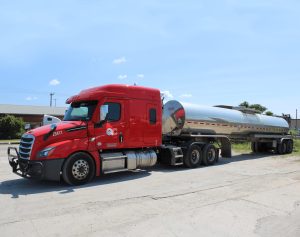Intermodal transportation is an innovative and efficient way of moving goods using multiple vehicles or transport modes, like trucks, trains, ships, and even planes. Instead of just one way of transportation, this method combines the best parts of different vehicles to save time, money, and energy. This system helps businesses and industries get products where they need to go quickly and cost-effectively, making it an important part of global trade and supply chains. But is intermodal transportation really on the rise? This question is important as more companies look for ways to make their supply chains faster, more efficient, and environmentally friendly.
According to a recent report from the Intermodal Association of North America (IANA), the total intermodal volumes rose by 8.8% in the first quarter of 2024 compared to the previous year. This growth was largely caused by an increase in international container volumes, which increased by 18%. The report highlights that consumer spending and global trade have significantly boosted the demand for intermodal services.
In this article, we will examine whether intermodal transportation is increasing and what factors are affecting its growth.
Is Intermodal Transportation on the Rise?

Yes, intermodal transportation is increasing. More businesses use this method to move goods because it is cost-effective and efficient. By combining different types of transportation, such as ships, trains, and trucks, companies can save time and money while reducing their environmental impact. This is especially important as global trade continues to grow and people expect faster product delivery.
Technological improvements and better logistics planning also drive the rise of intermodal transportation. Companies can now track shipments in real time, which helps reduce delays and improve overall service. With these advancements, intermodal transportation is becoming more popular for moving goods worldwide.
Developments Affecting the Increase of Intermodal Transportation
Recent studies show intermodal transportation is growing steadily. More companies are turning to it to move goods, as it offers clear advantages over relying on just one mode of transport. Several factors are driving this shift:
- Technology: Modern tracking systems and automation make managing and monitoring shipments easier, improving overall efficiency.
- Sustainability: As businesses face pressure to cut carbon emissions, intermodal trucking offers a greener alternative than relying solely on trucks.
- Global Trade: As international trade expands, so does the need for more complex transportation solutions that intermodal systems can provide.
- Economic Drivers: Rising fuel prices and the push for cost efficiency make rail transport, a key part of intermodal systems, an attractive option.
Challenges Affecting the Increase of Intermodal Transportation
Despite its growth, there are still challenges:
- Infrastructure Limitations: Not every region has the rail lines, ports, or terminals necessary to make intermodal transport systems fully effective.
- Coordination Issues: The need for coordination between different transport modes and operators can sometimes cause delays or hiccups.
- Regulations & Compliance: Navigating the rules and regulations in various countries can slow down the flow of goods.
- Delays: Weather, strikes, and other disruptions can affect the smooth running of intermodal systems.
Benefits of Intermodal Transportation
There are plenty of reasons intermodal shipping is increasing; these are:
- Cost Savings: By combining different transportation modes, businesses can reduce transportation costs, especially over long distances.
- Environmental Impact: Rail transport, a major component of intermodal systems, is far more fuel-efficient than trucks, helping reduce carbon footprints.
- Flexibility: It offers multiple routes and options, making finding solutions that suit delivery needs easier.
- Safety & Reliability: With various transport modes, goods are less likely to experience delays or damage, improving the overall reliability of the shipping process.
Industry Insights: Key Players and Innovations
Major players in the intermodal space are investing heavily in technology and infrastructure to support this growth. Shipping companies are adopting AI and predictive analytics to improve shipment tracking and make better routing decisions. On the infrastructure side, key intermodal hubs are expanding their capacity to handle the growing volume of goods moving across countries and continents.
Future Outlook of Intermodal Transportation

Intermodal carrier transportation is setting to grow even more. Predictions show that as global trade increases, the need for more sustainable and cost-effective transportation solutions will make intermodal transport a central piece of the logistics puzzle. Governments will likely support this growth with infrastructure investments, while businesses will continue adopting new technologies to streamline the process.
Intermodal transportation is increasingly becoming the go-to solution for businesses looking to lower costs and improve efficiency. Its ability to combine the strengths of different transport modes makes it clear why it’s gaining popularity and will continue to do so.
Final Thoughts
The growth of intermodal transportation shows no signs of slowing down. It’s providing businesses with a smarter, greener, and more cost-effective way to manage logistics, and with more investment in infrastructure and technology, it’s only going to keep growing.
FAQs
Intermodal transportation offers lower costs than traditional trucking, especially for long-distance shipments.
It’s cost-effective, flexible, and greener than using only trucks, making it more popular for businesses.
It saves money, reduces environmental impact, offers flexibility in routing, and improves safety and reliability in transporting goods.
Limited infrastructure in some areas, coordination issues between different modes, and regulatory complexities are the main challenges.
With more investment in infrastructure and tech, it will continue to grow, offering more efficient and sustainable shipping solutions.




